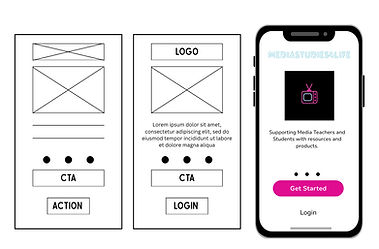Production Work
Practical Production is one of the things that sets a Media Studies course apart from other subjects. Here you'll find some resources to help you plan your creative projects.
Before you get started, here are 5 top tips:
-
Start with strong research: Look at real-world examples in your chosen medium to see how professionals use codes and conventions.
-
Know your audience: Think carefully about who you’re making your product for and how you’ll appeal to them.
-
Plan before you produce: Use storyboards, scripts or mock-ups to test out your ideas before you start filming, designing or editing.
-
Experiment with technology: Don’t be afraid to try out new tools, software, or techniques to bring your vision to life.
-
Reflect as you go: Keep notes on your creative choices and challenges. This will make your evaluation much easier (and stronger) or help prepare you for the next project.
What is...
A MOCK UP
DEFINITION: A mock-up is a rough, usually simplified, visual draft of a media product that shows what the final version is intended to look like. It isn’t the polished finished piece but instead a planned design that communicates your ideas clearly. Think of it as a "visual plan".
THE PURPOSE IS TO:
-
Demonstrate planning.
-
Test out ideas for layout, design and conventions.
-
Get feedback before committing to the full production.
KEY FEATURES (depending on the type of production):
-
Magazine coursework → a mock-up might be a sketched or digital draft of the front cover and contents page, showing layout, where images and text will go, and the overall style.
-
Film poster coursework → a mock-up would be a rough version of the poster with placeholder images, font ideas, and positioning of titles/credits.
-
Website coursework → a mock-up might show the homepage and subpages, outlining the navigation and content placement.
-
Moving image coursework (e.g., a short film or music video) → a mock-up could be in the form of a storyboard (visual plan of shots) or a draft edit with placeholders.

A WIREFRAME
DEFINITION:
A wireframe is a basic outline or skeleton of a media product that shows the structure and layout without detailed images, colours, or final text. It focuses on how content is arranged and how users will navigate, rather than on the finished design. Think of it as a "blueprint".
THE PURPOSE IS TO:
-
Plan the structure and organisation of the product.
-
Focus on usability and navigation before adding style.
-
Save time by solving layout problems early.
KEY FEATURES:
-
Websites → homepage, menus, content blocks, sidebars, footers.
-
Apps → screen layouts, buttons, icons and navigation flow.
-
Digital magazines/e-books → placement of text, images and interactive elements.
-
Online Adverts → positioning of text, image, and call-to-action buttons.
-
Interactive media (e.g., games, online platforms) → basic structure of screens or levels before visuals are added.

FIDELITY
DEFINITION:
In media production, fidelity describes how detailed and realistic a draft, prototype, or design is.
-
Low fidelity → simple, rough, and quick. Focuses on basic layout and ideas (like sketches, stick figures, or plain boxes).
-
High fidelity → detailed, polished, and close to the final product. Includes real images, fonts, colours, and interactive features.
Think of it as the difference between a rough sketch and a finished poster.
THE PURPOSE IS TO:
-
Low fidelity → save time, test early ideas and get feedback before committing effort.
-
High fidelity → show exactly how the final product will look and function, ready for testing or approval.
KEY FEATURES:
-
Low fidelity examples: hand-drawn wireframes, rough mock-ups, storyboards with stick figures, draft edits with placeholder text or images.
-
High fidelity examples: polished magazine spreads with chosen fonts/images, a near-complete website design, a professional poster draft, a video edit with transitions and sound.







